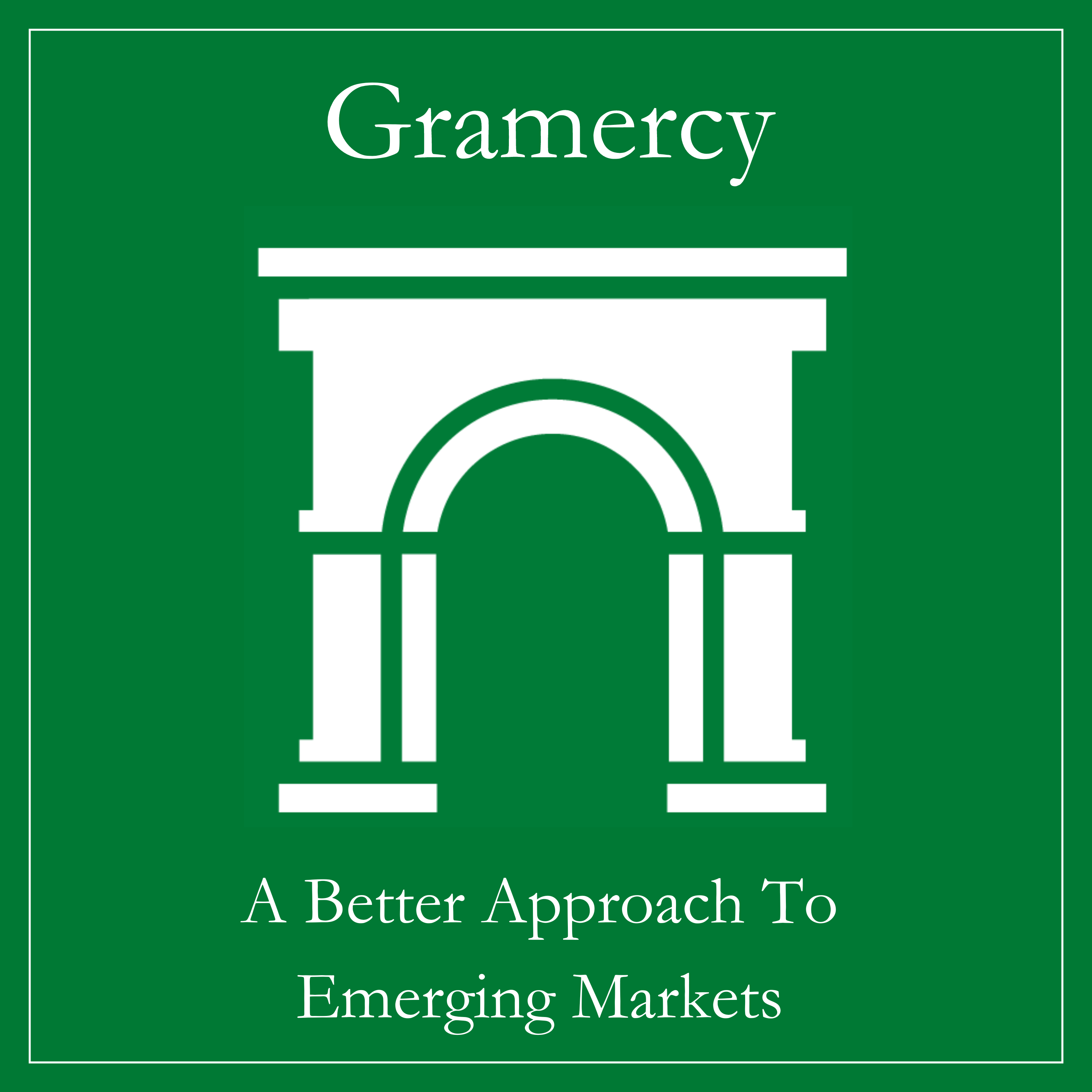Contents
Market Overview
Macro Review
A week dominated by politics. Other than U.S. events that were well telegraphed, Sri Lanka’s Parliamentary elections offered the incumbent President a large majority. As Presidential elections in September saw the opposition exceed expectations, there is a growing prospect that a similar story will emerge in Ghana with elections in December. However, Georgian elections on October 26th were protested once again this week with large demonstrations. German political parties agreed to hold an early federal election on February 23th, with Chancellor Scholz tabling a confidence vote on December 16th. In Japan, Ishiba-san was re-elected as Prime Minister as expected, but policy uncertainty remained elevated due to his minority government. Finally, the idea of politics creeping into monetary policy was visible as Thailand’s former Finance Minster was appointed as Chairman of the Bank of Thailand’s Board. After China’s Standing Committee of the National People’s Congress approved a one-off RMB10tn debt swap on November 8th, there was progress as the province of Henan raised RMB32bn under the facility. The forward guidance around consumption and additional property measures was also supportive. The underlying message was that Chinese authorities were reserving a full suite of stimulus tools until there is more clarity on the Trump Administration’s protective agenda. Back to the U.S. but focusing on macroeconomics. Chair Powell’s Jackson Hole speech was widely perceived as dovish in August as he referenced that it was time for policy to adjust. His commentary last week was hawkish and there is growing uncertainty that the Federal Reserve may not cut interest rates in December. Chair Powell explicitly said that the economy “is not sending any signals that we need to be in a hurry to lower rates”, and that its strength “gives us the ability to approach our decisions carefully”. This notion of uncertainty was supported by Fedspeakers from Kashkari to Schmid to Musalem. Governor Logan went further to argue that term permia was still low and the policy combination suggested that the U.S. treasury curve ought to twist steepen. In this regard, U.S. Treasuries saw the 10-year note rise to the highest yield since July, with the 30-year at its highest level since April. On a 2s30s curve basis, last week recorded one of the largest weekly steepening periods of 2024. Kashkari’s view was that there would need to be “a surprise on the inflation front to change the outlook so dramatically”. The narrative was clearly around strong and stubbornly high CPI and PPI. It is therefore of little surprise that the U.S. dollar is at its strongest level in over a year, and EUR and JPY depreciated meaningfully this week. Layering U.S. politics on top of this conundrum creates further challenges.
EM Credit Update
Emerging market sovereign credit (cash bonds) ended the week down -0.7% with credit spreads 1bp tighter. Sovereign outperformers were Ukraine, Argentina and El Salvador, while Ecuador, Ethiopia and Tunisia underperformed. The main laggard of the past week was GBI-EM local currency bonds that were down 1.7%. Given the strength in USD over the week, it was clear that EMFX would suffer and the South African rand was one of the largest underperformers. The strength in “Trump trades” was clearly visible and this culminated in Fitch upgrading Argentina to CCC from CC.
The Week Ahead
The course of next week will share some focus on inflation out of Japan, the UK and Canada. Politics will likely interrupt this focus. UK headline inflation is likely to show signs of reacceleration above the Bank of England’s 2% target in October, mainly due to higher household energy bills. There is still a strong belief that the quarterly cutting cycle will be maintained. In Turkey, the November decision is largely a hold where the debate is more open in terms of a large cut in December or 1Q. Moderating inflation in South Africa is another key talking point, which would allow the SARB to cut 25bps, although the debate around a lower inflation target may creep back into the conversation. China’s one-year MLF rate is expected to remain unchanged at 2.0%, which is the same story across the one-year and five-year Loan Prime Rates. In the meantime, Mexico’s FY25 budget was presented at the end of this week and will continue to be digested over the weekend.
Highlights from emerging markets discussed below: Mexico policy rate cut by 25bps; moderate consolidation put forth in 2025 draft budget and Ukraine likely to resist an unfavorable “peace deal”; conflict likely to drag on, contrary to consensus bets on a near-term resolution.
Fixed Income
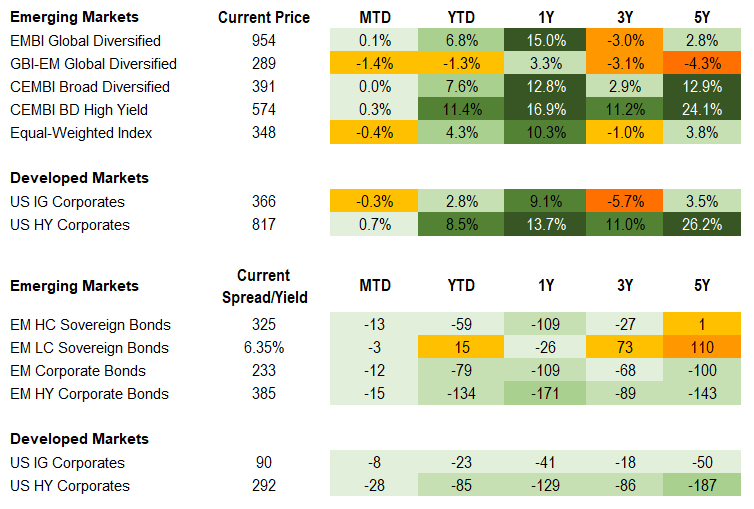
Equities
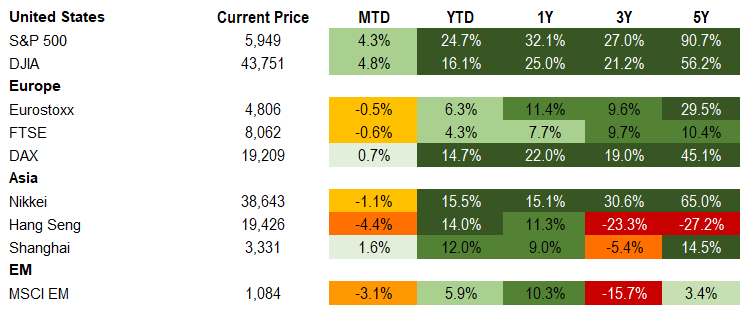
Commodities

Source for data tables: Bloomberg, JPMorgan, Gramercy. EM Fixed Income is represented by the following JPMorgan Indicies: EMBI Global, GBI-EM Global Diversified, CEMBI Broad Diversified and CEMBI Broad High Yield. DM Fixed Income is represented by the JPMorgan JULI Total Return Index and Domestic High Yield Index. Fixed Income, Equity and Commodity data is as of November 15, 2024 (mid-day).
Emerging Markets Weekly Highlights
Mexico policy rate cut by 25bps; moderate consolidation put forth in 2025 draft budget
Event: Banxico unanimously lowered its policy rate to 10.25% from 10.50% in line with market consensus. While the outlook continues to call for a restrictive monetary policy stance, the evolution of inflation allowed the Board to reduce the level of restriction, according to the Central Bank’s statement. The Board continues to envision an inflation path that allows for further rate adjustments. The 2025 draft budget presented to Congress at the end of the week targets a broad deficit of 3.9% of GDP down from 5.9% of GDP, debt to GDP of 51.4%, growth between 2-3%, inflation at 3.5% by end-2025 and MXN at 18.7. The Government’s pledge of support to Pemex continues with a consolidated tax rate and coverage of 2025 repayments. Just ahead of the budget, Moody’s revised its outlook on Mexico’s Baa2 rating to negative.
Gramercy Commentary: We think cautious easing and forward guidance for additional adjustments in the aftermath of the recent Fed 25bps cut has been well digested, as expected by the market, and real rates remain high. Roughly 2% points of GDP in fiscal consolidation is a positive step albeit with the need for more to be done over the medium-term including possible tax reform. We expect the Government’s support to Pemex to remain robust and deepen over time with recent reforms and reiterated commitment in this year’s budget presentation. While rating pressure remains to the downside, we expect the IG status to be retained in the near-term. At the same time, policy signals and actions from the new U.S. Administration will be a key matter for Mexican assets heading into 2025.
Ukraine likely to resist an unfavorable “peace deal”; conflict likely to drag on, contrary to consensus bets on a near-term resolution
Event: Since Donald Trump’s re-election as U.S. President and confirmation of a full Republican Congressional control , markets have been increasingly pricing in a “near-term peace deal” scenario for Ukraine, propelling the restructured sovereign bond complex to a top performer across EM hard currency sovereign assets month-to-date.
Gramercy Commentary: Although the improbable inclusion of Ukraine among the so called “Trump trades” has created a tactical trade opportunity, we believe that markets have gone ahead of the likely extremely complicated geopolitical realities of achieving a sustainable conflict resolution in Ukraine at some point in the future. For the time being, we believe A) a peace deal is unlikely in 2025, despite aggressive rhetoric to the contrary by the incoming Trump 2.0 Administration and B) if a deal does materialize next year, we think that it would almost certainly be a “bad deal” for Ukraine, i.e. one forced upon the country as a result of both U.S. and European economic and military support abruptly plummeting. We believe such a scenario carries a low probability, despite likely dwindling U.S. financial and military assistance to Ukraine after Mr. Trump re-enters the Oval Office in January. We expect the lame duck Biden Administration to maximize U.S. funding for Ukraine and a step up of EU assistance (the Union has provided the bulk of budget financing for Ukraine since 2022) and multilateral donors in the near-term to enable Ukraine to “fight effectively in 2025 or to be able to negotiate a peace deal from a position of strength” as described by outgoing U.S. State secretary Blinken at a NATO meeting this week. Furthermore, both Blinken’s successor as State Secretary, Marco Rubio, and Mr. Trump’s incoming National Security Advisor, Mike Waltz, have been supportive of Ukraine in the past, which could also work as a mitigating factor on the White House’s Ukraine policy come January 2025, in our view.
Emerging Markets Technicals
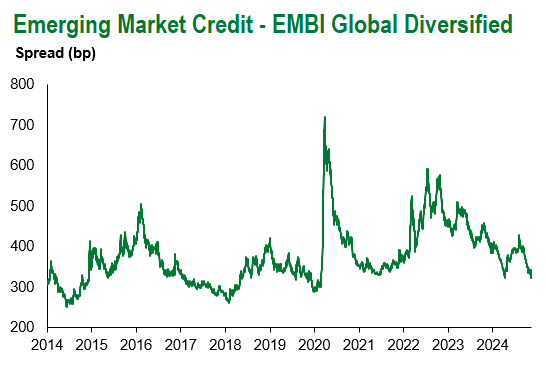
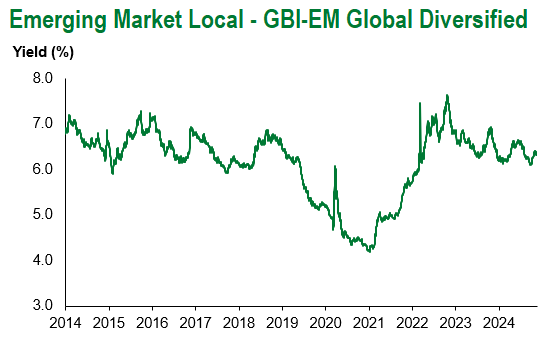
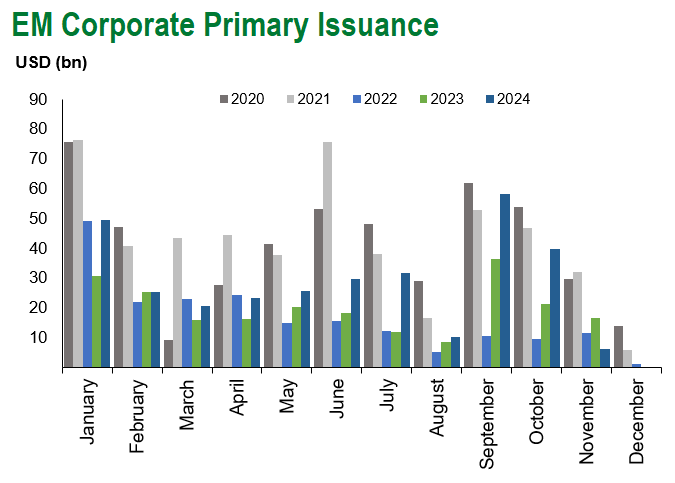
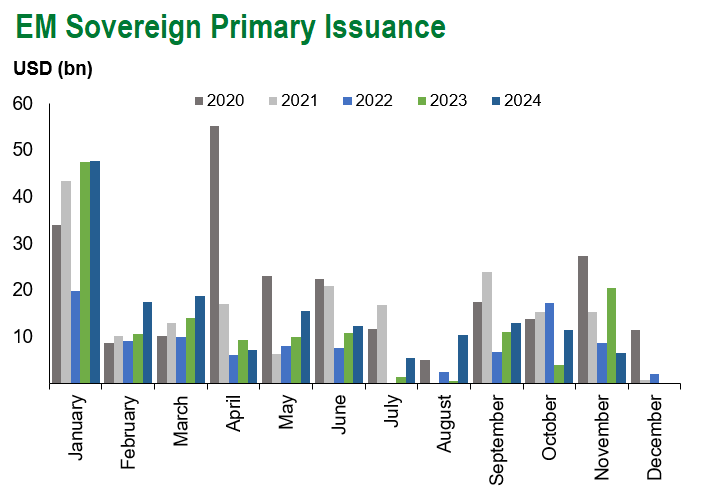
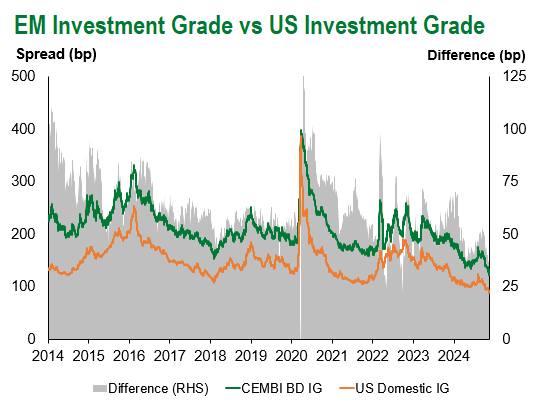

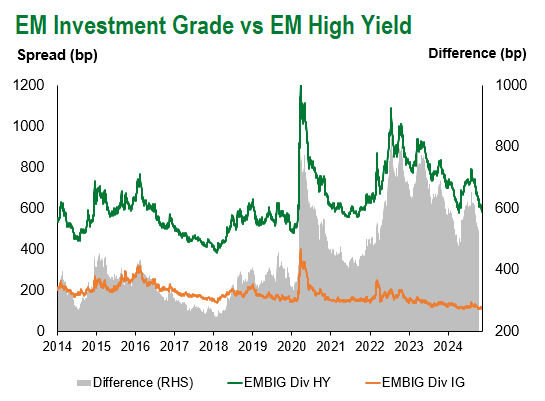
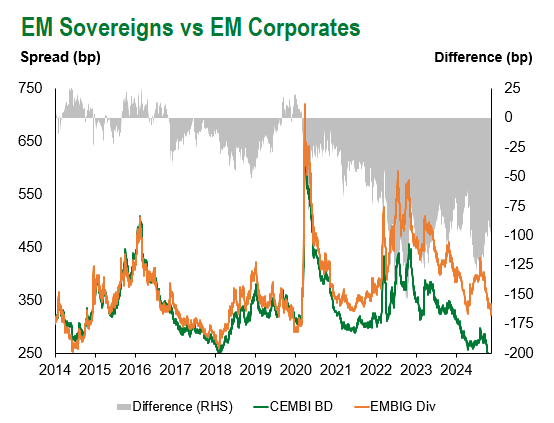
Emerging Markets Flows
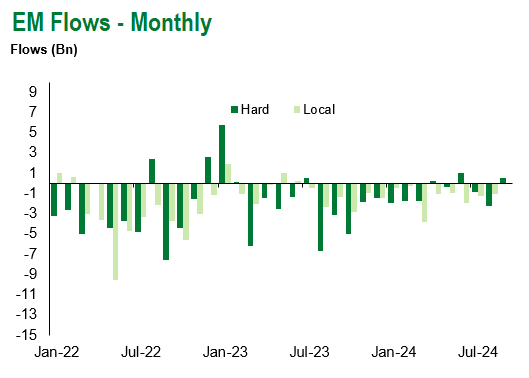
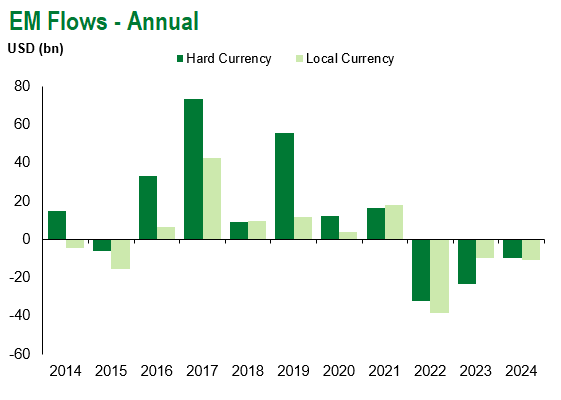
Source for graphs: Bloomberg, JPMorgan, Gramercy. As of November 15, 2024.
For questions, please contact:
Kathryn Exum, CFA ESG, Director, Co-Head of Sovereign Research, [email protected]
Petar Atanasov, Director, Co-Head of Sovereign Research, [email protected]
James Barry, Director, Deputy Portfolio Manager, [email protected]
This document is for informational purposes only. The information presented is not intended to be relied upon as a forecast, research or investment advice, and is not a recommendation, offer or solicitation to buy or sell any securities or to adopt any investment strategy. Gramercy may have current investment positions in the securities or sovereigns mentioned above. The information and opinions contained in this paper are as of the date of initial publication, derived from proprietary and nonproprietary sources deemed by Gramercy to be reliable, are not necessarily all-inclusive and are not guaranteed as to accuracy. This paper may contain “forward-looking” information that is not purely historical in nature. Such information may include, among other things, projections and forecasts. There is no guarantee that any forecasts made will come to pass. Reliance upon information in this paper is at the sole discretion of the reader. You should not rely on this presentation as the basis upon which to make an investment decision. Investment involves risk. There can be no assurance that investment objectives will be achieved. Investors must be prepared to bear the risk of a total loss of their investment. These risks are often heightened for investments in emerging/developing markets or smaller capital markets. International investing involves risks, including risks related to foreign currency, limited liquidity, less government regulation, and the possibility of substantial volatility due to adverse political, economic or other developments. References to any indices are for informational and general comparative purposes only. The performance data of various indices mentioned in this update are updated and released on a periodic basis before finalization. The performance data of various indices presented herein was current as of the date of the presentation. Please refer to data returns of the separate indices if you desire additional or updated information. Indices are unmanaged, and their performance results do not reflect the impact of fees, expenses, or taxes that may be incurred through an investment with Gramercy. Returns for indices assume dividend reinvestment. An investment cannot be made directly in an index. Accordingly, comparing results shown to those of such indices may be of limited use. The information provided herein is neither tax nor legal advice. Investors should speak to their tax professional for specific information regarding their tax situation.
